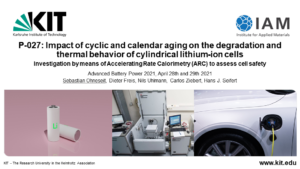Summary:
Lithium-ion batteries (LIB) are experiencing a significantly increasing demand for consumer goods, as well as for battery electric and hybrid electric vehicles. The broad usage possibilities of medium sized cylindrical cells, e.g. of size 18650 and 21700, results in multifaceted requirements and usage conditions. In consequence, the performance of these cells in everyday usage and their degradation through different usage and storage conditions is of particular interest.
At the Institute of Applied Materials – Applied Materials Physics (IAM-AWP), we have established battery calorimetry as a versatile characterization technique, which allows advancements for the thermal management and the safety of batteries. With six adiabatic Accelerating Rate Calorimeters (ARC) of different sizes and two sensitive Tian-Calvet calorimeters combined with cyclers we operate Europe’s largest battery calorimeter center.
The overall goal of this still ongoing study is to understand and compare the cyclic and calendar aging processes in LIB. The aging in usage and storage is analyzed in commercial cells, built with state of the art electrodes. Different usage conditions during cycling are represented by different discharging rates and load profiles. The phases of rest and storage are simulated by storing the cells in incubators at defined temperatures and states of charge. The results of these ageing experiments are compared for commercial lithium-ion cells with different cylindrical cell sizes and cathode materials.
For assessing the impact of different aging parameters and states on the safety, the cells are thermally abused using the Heat-Wait-Seek (HWS) test in an ARC. At a SOH of 80 % cyclic aged 18650 cells show increased exothermic reactions in the low temperature range, which might be attributed to a small amount of plating. The cells which have been cycled at high rates show a vent opening and reach the critical temperature rate of 10 °C/min at higher temperatures than the fresh cells, which can be attributed to the lower capacity of the aged cells. Thus, it can be concluded that for these cells the safety level is not negatively affected when they reach a SOH of 80%.
We are happy to forward your request / feedback.

